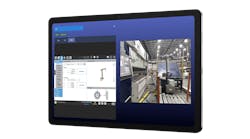My column, “To PLC or not to PLC? That is the question,” discussed the emerging trend toward PC-based control and non-ladder-logic programming. Once the preamble about the histories of PC- vs. PLC-based controls was tabled, the subject came down to the trend of PC-based control and how that is changing the type of subject-matter experts we depend on for new control systems. Schools of higher education tend to focus on the PC-based programming as it streamlines the course curriculum greatly. After all, it makes sense to teach Java, C, Visual Basic or SQL to a greater group that could end up in either IT or the controls industry, rather than keeping the two separate.
I, like many seasoned—“old” just doesn’t feel right—engineers, tend to lament the trend away from ladder-logic-based systems. I suppose part of it is the built-in resistance to change that all of us feel as we get older, but for me there is more at stake than the apparent longing for the old days. Technology changes at an ever-increasing rate, but, contrary to popular thinking, not all change is good over the long haul.
One example of rapidly progressing technology is the cellular phone. It is obvious that a cell phone is much more than a phone these days. The ever-expanding base of applications to run on smartphones is pushing the base technology into areas that would not have been thought of when the first phones started showing up in cars all those years ago.
One can’t really keep a phone more than two years without getting drastically behind on the features of the newer phones. For several years now, applications on a smartphone have made their way into the controls arena as an interface to network or Web-based software. It just makes sense to leverage the connectivity to a network by a smartphone to access process monitoring software, for example. That smartphone is just hanging around in our back pocket, so why not use it?
The decision becomes less clear when it comes to the platform where actual control system resides. Newer phones providing an interface to software residing on a network or on a cloud-based application is much different from the expense and complexity of a control system designed to control processes or whole plants, for example.
Until smartphones get sophisticated enough to be control platforms—can we imagine such a day? —the smartphone will always be a window, or interface, into a world based on a different platform.
A reader recently sent me a long email about how he has had to deal with the ramifications of choosing PC-based control platforms. His story is like many in the industry. He has many machines out there on a PC-based platform. The hardware cost is about one-third that of a conventional PLC system and is smaller.
Product support is free forever, in his words, and the hardware vendor doesn’t ask for personal information, so it can pester you about end of support and other marketing gimmicks. Another upside is the scan times are fractions of that from a legacy PLC or even the newer PAC platforms. All great reasons to go with a PC-based control design.
With all that upside, what this particular reader now faces is an established client base of multi-million dollar machines functioning just fine on the very stable Windows XP platform, and, while they have worked great for many years, the Intel hardware and Microsoft software the phase-outs of the products were scheduled to fall within a year of each other.
First came the calls to the client’s own IT department with the pending doomsday and end-of-support notices followed by the actual failure of the PCs themselves. Computers, as we know, don’t last forever, and eventually they will fail.
The journey for this particular reader matched closely with the struggle I had with some legacy equipment recently. Hardware platforms and operating systems go hand in hand. I have had a lot of heartache recently with the whole 32-bit/64-bit situation, coupled now with the retirement of Windows XP.
I have a very nice application running on a brand-name motion PLC platform. We haven't had to adjust anything on the machine since I installed it back when I was a vendor for what is now my employer. We wanted to add a new pack pattern to the machine.
The original laptop that I had the programming software on went belly-up recently, and I have been trying to recreate it as a virtual machine. It has been a train wreck that I have yet to get resolved. I have the original install disc for the XP machine, but, like most install disks, it was tied to the original hardware, in this case an HP laptop.
Since Microsoft no longer supports Windows XP, I am having fits trying to get the install to work properly on a virtual PC I set up. You simply can’t purchase a 32-bit Intel processor from any reputable source; nor can you get help with transferring a 15-year-old license for the operating system to a new computer, even if you were able to purchase one. Imagine trying to set up a 32-bit operating system on a 64-bit Windows 10 host machine and then running 32-bit software on it.
You can imagine where I am with the whole experience.
Here is another consideration: Most PC-based applications require specialty cards mounted in slots in the motherboard to provide communications and I/O interface connections. Those modules have not been updated over the years to follow the progress of the hardware and operating systems. When suddenly faced with trying to upgrade a computer system to new technology, the designer is often faced with specialty daughterboards for which there is no replacement available in the marketplace today.
My reader listed the relative cost of upgrades for one of his machines if the base unit fails and came up with a number around $10,000 per unit. That is a number that any client would balk at, and, yet, that is the price they are faced with when these older architectures fail, as they surely will.
So, as we can see from the experiences of my reader and my own tribulations, the pros of PC-based vs. PLC-based control didn’t really matter all that much when faced with the inevitable failure of the hardware at the core of the control system.
One can easily slip into conspiracy-theory mode and wonder about the collaboration behind the scenes that forces users to reinvest in their long-lived machines and processes just because someone in a boardroom somewhere decided that it is time to retire an operating system or the chipset that it’s based on. For the designers of what have become legacy control systems, we find ourselves morally bound to find solutions for our clients who are faced with swallowing a rather bitter pill.
As I write this article, the year is drawing to a close. It is time to reflect back on the year that just was and anticipate the year that is to come. I particularly enjoy getting reader responses to articles that appear here in Control Design magazine. While we all come from a variety of backgrounds and find ourselves in many different disciplines, the collective experiences create a community in which we are all brothers and sisters. The common thread will always be desire to improve upon the world in which we live and find better ways to cope with the challenges that we face on a day-to-day basis.
Technology will always move forward, and we will always feel compelled to move along with it. There is no complacency in control design. We will forever accept the call to do more at a faster rate with more sophistication than we did before. That is human nature, and ultimately it is the drive that makes what we do so worth the effort. Keep those letters coming, and don’t hesitate to drop me a line if you find a subject that provokes thought.






